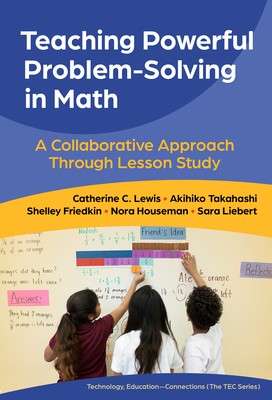
- We will send in 10–14 business days.
- Author: Catherine C Lewis
- Publisher: Teachers College Press
- ISBN-10: 0807787590
- ISBN-13: 9780807787595
- Format: 16.2 x 23.2 x 2.1 cm, kieti viršeliai
- Language: English
- SAVE -10% with code: EXTRA
Reviews
Description
In Teaching Powerful Problem-Solving in Math , readers will visit urban elementary and K-8 schools where teachers have dramatically transformed learning for teachers and for students.
Students learn mathematics by confronting a novel problem and building the new mathematics needed to solve it, just as mathematicians would. Learning in this way, students discover the power of their own thinking and gain confidence that extends well beyond mathematics.
See how teachers transform instruction using schoolwide lesson study, building powerful new ways to learn from each other, practice, and research. In-depth classroom portraits, at the outset of schoolwide lesson study and three years later, illuminate the changes in mathematics instruction at a school that grew its proficiency on Smarter Balanced Assessment from 15% to 56% over three years.
Extensive resources and links allow readers to understand and build on the work of these schools, which is grounded in established principles of collective efficacy, intrinsic motivation, and learner agency for both students and teachers.
Book Features:
- Profiles teachers leading the transformation of instruction to achieve the ambitious vision of learning embodied in recent standards.
- Shows how teaching through problem-solving can erase the achievement gap in mathematics learning.
- Provides the first in-depth portrait of schoolwide lesson study, showing how U.S. teachers at several schools build it and use it to transform teaching.
- Uses photographs, student work, and detailed classroom descriptions to bring to life mathematics lessons in year 1 and year 4 of the school's work to build problem-solving.
- Provides examples and links to the strategies teachers use to make student thinking visible (and actionable) during mathematics lessons.
- Includes lesson plans, photographs of board work, student journals, school newsletters, self-assessment rubrics and dozens of links to the resources needed to begin using teaching through problem-solving and school-wide lesson study.
- Provides long-term, teacher-led solutions for professional learning and for mathematics instruction that have been shown to improve teacher retention and student proficiency.
EXTRA 10 % discount with code: EXTRA
The promotion ends in 22d.12:28:32
The discount code is valid when purchasing from 10 €. Discounts do not stack.
- Author: Catherine C Lewis
- Publisher: Teachers College Press
- ISBN-10: 0807787590
- ISBN-13: 9780807787595
- Format: 16.2 x 23.2 x 2.1 cm, kieti viršeliai
- Language: English English
In Teaching Powerful Problem-Solving in Math , readers will visit urban elementary and K-8 schools where teachers have dramatically transformed learning for teachers and for students.
Students learn mathematics by confronting a novel problem and building the new mathematics needed to solve it, just as mathematicians would. Learning in this way, students discover the power of their own thinking and gain confidence that extends well beyond mathematics.
See how teachers transform instruction using schoolwide lesson study, building powerful new ways to learn from each other, practice, and research. In-depth classroom portraits, at the outset of schoolwide lesson study and three years later, illuminate the changes in mathematics instruction at a school that grew its proficiency on Smarter Balanced Assessment from 15% to 56% over three years.
Extensive resources and links allow readers to understand and build on the work of these schools, which is grounded in established principles of collective efficacy, intrinsic motivation, and learner agency for both students and teachers.
Book Features:
- Profiles teachers leading the transformation of instruction to achieve the ambitious vision of learning embodied in recent standards.
- Shows how teaching through problem-solving can erase the achievement gap in mathematics learning.
- Provides the first in-depth portrait of schoolwide lesson study, showing how U.S. teachers at several schools build it and use it to transform teaching.
- Uses photographs, student work, and detailed classroom descriptions to bring to life mathematics lessons in year 1 and year 4 of the school's work to build problem-solving.
- Provides examples and links to the strategies teachers use to make student thinking visible (and actionable) during mathematics lessons.
- Includes lesson plans, photographs of board work, student journals, school newsletters, self-assessment rubrics and dozens of links to the resources needed to begin using teaching through problem-solving and school-wide lesson study.
- Provides long-term, teacher-led solutions for professional learning and for mathematics instruction that have been shown to improve teacher retention and student proficiency.


Reviews